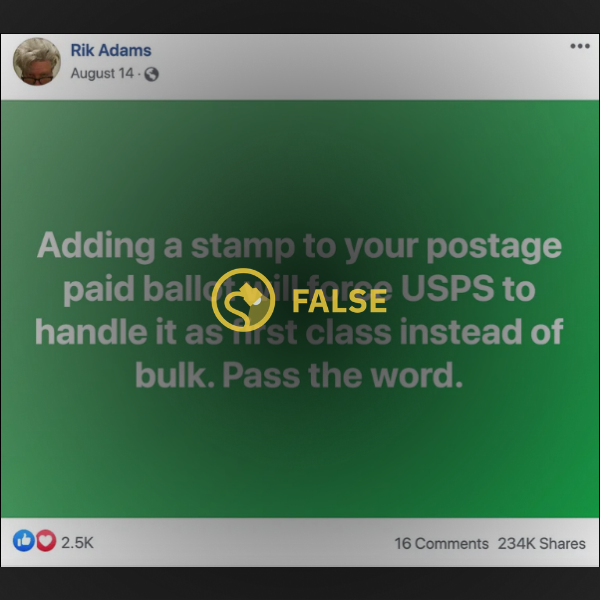In August 2020, readers sent Snopes multiple inquiries about a widely shared Facebook post that claimed voters could "force" the U.S. Postal Service to treat a postage-paid ballot as "first class" by adding a stamp.
The claim, which was posted on Aug. 14, 2020, read: "Adding a stamp to your postage paid ballot will force USPS to handle it as first class instead of bulk. Pass the word."
The post's claim was inaccurate.
A spokesperson for the Postal Service told Snopes that, in cases where a ballot is "postage paid" when received by the voter (the scenario mentioned in the Facebook post), that ballot is already automatically treated as "first class," and so adding a stamp would make no difference to its delivery time. In an emailed statement, the spokesperson wrote:
"If postage on a returning ballot envelope is pre-paid by election officials it is First-Class Mail, so adding postage to the envelope is unnecessary and will not enhance service."
The premise of the Facebook post was that postage-paid ballots are processed as bulk or standard mail as default and that adding a stamp would "force" the Postal Service to treat the ballot as first class. That premise was false, since the Postal Service already treats postage-paid ballots as first class, and there is no need for the postal service to be "forced" to do something they already do.
According to the National Conference of State Legislatures, 17 states have policies of prepaying postage on mail-in ballots. In addition, Pennsylvania, Massachusetts, and South Carolina will be prepaying postage for elections in 2020, in light of the ongoing COVID-19 coronavirus pandemic.
In some states, such as Illinois and Utah, the policy on postage varies between counties, and some states and local election boards also provide drop boxes, which obviate the need for postage. In regions where postage is not prepaid, the Postal Service "requires election officials to inform voters of the amount of First-Class postage required to return their ballots," the agency's spokesperson told Snopes.
However, even if a voter is required to add first-class stamps to their mail-in ballot, but they don't, the Postal Service's policy is to process and deliver that ballot anyway, and then charge the local Board of Elections for the postage. The spokesperson added:
"If a return ballot is nevertheless entered into the mailstream with insufficient or unpaid postage, it is the Postal Service’s policy not to delay the delivery of completed absentee or vote-by-mail ballots. We are proactively working with state and local election officials on mailing requirements, including postage payment. In cases where a ballot enters the mailstream without the proper amount of postage, the Postal Service will collect postage from the appropriate Board of Elections.”


